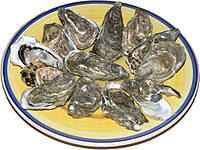
Photo from wikipedia
Oyster breakwater reefs used for coastal protection have shown to enhance local biodiversity. Particularly, macro-invertebrate and fish assemblages can benefit directly from reefs providing structurally complex habitats and indirectly through… Click to show full abstract
Oyster breakwater reefs used for coastal protection have shown to enhance local biodiversity. Particularly, macro-invertebrate and fish assemblages can benefit directly from reefs providing structurally complex habitats and indirectly through alteration of soft-sediment environment near the reef areas. To test this hypothesis, a manipulative field experiment was carried out on an eroding intertidal flat in the southeastern coast of Bangladesh by deploying replicate units of each 20 m long oyster breakwater reefs specially designed to protect adjacent shorelines. Transient fishes and resident intertidal macro-invertebrate communities were assessed monthly for a period of 18 months. On the intertidal flat, five transects were setup for faunal and environmental data collection, three crossing the breakwater reefs and two along the control areas without reefs. Prior to the deployment of the reefs, both the macro-invertebrate and fish assemblage were not significantly different among the five transects, indicating a rather uniform distribution of species in all tidal flats. Data collected post-reef deployment revealed that oyster breakwater reefs supported a greater biomass as well as abundance of benthic macro-invertebrates on the landward mudflat behind the reefs than the mudflat of control sites. The community structure, and seasonal variation of the macrobenthic community were associated with the variations in the sediment accumulation, as influenced by the breakwater reefs. Additionally, higher abundance of transient finfish and mobile macro-invertebrates at the reef sites suggest that the faunal communities were attracted by the higher abundance of prey resources (i.e. polychaetes, small crustaceans, juvenile gastropods and bivalves) as supported by the reefs. Thus, the reef areas served as shelter, nursery, and foraging grounds for different species. Though the ecological benefits of using oyster breakwater reefs only span adjacent to the reefs, this study confirms the importance of reef structure in facilitating local coastal biodiversity in a subtropical region.
Journal Title: Ecological Engineering
Year Published: 2020
Link to full text (if available)
Share on Social Media: Sign Up to like & get
recommendations!